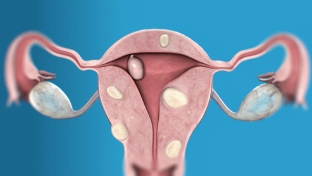Uterine fibroids are by far one of the most common gynecological diseases. Many factors influence the occurrence of this disease, and today it is not possible to reliably explain what reason causes the development of this benign neoplasm of the uterus. Since the pathology quite often affects women of reproductive age, the detection of uterine fibroids during pregnancy is not uncommon. But even this pathology is not an indication for termination of the onset of pregnancy. Read about the features of pregnancy and childbirth in a woman with uterine fibroids at estet-portl.com.
What to do if a woman is diagnosed with uterine fibroids during pregnancy
Uterine fibroids are diagnosed during pregnancy in approximately 2.5% of cases. This neoplasm consists of muscle and fibrous cells in different proportions and has a benign character. Since with a submucosal or submucosal location of the myomatous node, in most cases, infertility develops or spontaneous abortions occur, with a saved pregnancy, the subserous and interstitial location of the myomatous node is most often diagnosed. Often, uterine fibroids during pregnancy do not manifest themselves in any way and are diagnosed by chance, during a routine ultrasound examination.
Uterine fibroids during pregnancy:
- what can cause complications of uterine fibroids during pregnancy;
- management of patients with uterine fibroids during pregnancy;
- features of labor management in women with uterine fibroids.
What can cause complications of uterine fibroids during pregnancy
The presence of uterine fibroids during pregnancy causes certain features of the period of bearing a child. Such a pregnancy may be complicated by the following conditions:
- early termination of pregnancy;
- development of placental insufficiency followed by hypoxia and fetal hypotrophy;
- breech presentation or incorrect position of the fetus in the uterus in case of low localization of the myomatous node;
- malnutrition in the myomatous node;
- very rarely, septic necrosis of the myomatous node can develop.
It is important to remember that the location of the myomatous node plays a key role in predicting the course of pregnancy and subsequent births.

Management of patients with uterine fibroids during pregnancy
The management of patients with uterine fibroids during pregnancy is aimed primarily at preventing the development of pathological complications and maintaining pregnancy. Throughout such a pregnancy, it is necessary to monitor the condition of the fetus and eliminate signs of placental insufficiency as early as possible. When the first signs of impaired blood supply to the myomatous node appear, a woman should be prescribed drugs that improve blood flow, which include antispasmodics, trental and rheopolyglucins. If the effect of conservative therapy is absent, the woman must be operated on to remove the myomatous node. In the postoperative period, it is necessary to prevent abortion by prescribing drugs that reduce the contractile activity of the uterus.
Peculiarities of labor management in women with uterine fibroids
The issue of delivery in women diagnosed with uterine fibroids during pregnancy must be resolved even before delivery, so such patients are hospitalized a week before the expected date of delivery. A caesarean section is the most commonly used delivery option, for which there are many indications: fetal hypoxia, fetal malposition, pregnancy prolongation, gestosis, and so on. After removing the child from the uterine cavity, the myomatous nodes are often removed and only then the surgical wound is sutured. If childbirth is carried out through the natural birth canal, it is necessary to constantly monitor the fetal heartbeat and the ability of the uterus to contract. After childbirth, manual separation of the placenta is performed and infusion therapy is prescribed to prevent malnutrition in the myomatous node.






Add a comment